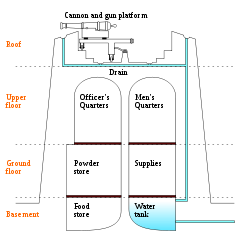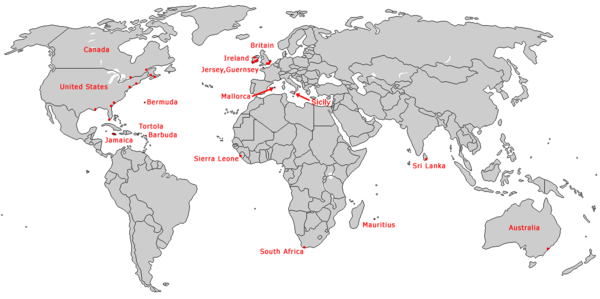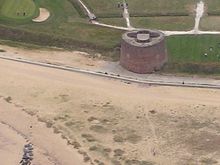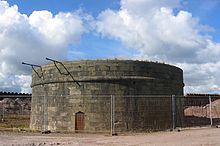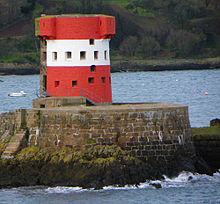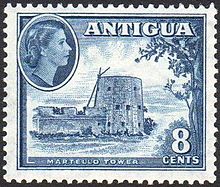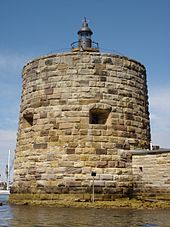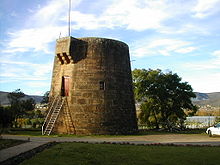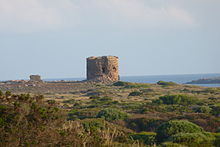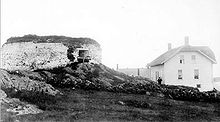- Martello tower
-
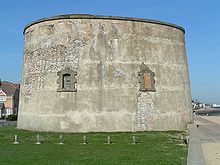 A Martello tower at Clacton-on-Sea on the east coast of England.
A Martello tower at Clacton-on-Sea on the east coast of England.
Martello towers (or simply Martellos) are small defensive forts built in several countries of the British Empire during the 19th century, from the time of the Napoleonic Wars onwards.
They stand up to 40 feet (12m) high (with two floors) and typically had a garrison of one officer and 15–25 men. Their round structure and thick walls of solid masonry made them resistant to cannon fire, while their height made them an ideal platform for a single heavy artillery piece, mounted on the flat roof and able to traverse a 360° arc. A few towers had moats for extra defence.
The Martello towers were used during the first half of the 19th century, but became obsolete with the introduction of powerful rifled artillery. Many have survived to the present day, often preserved as historic monuments.
Contents
Origins
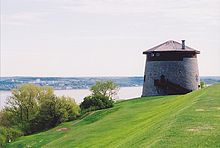 A Martello tower on the plains of Abraham in Quebec City (Quebec, Canada), at the top of Cap Diamant overlooking the Saint Lawrence River.
A Martello tower on the plains of Abraham in Quebec City (Quebec, Canada), at the top of Cap Diamant overlooking the Saint Lawrence River.
Martello towers were inspired by a round fortress, part of a larger Genovese defence system, at Mortella (Myrtle) Point in Corsica (see picture here [1]). The designer was Giovan Giacomo Paleari Fratino (el Fratin),[2] and the tower was completed in 1565.
Since the 15th century, the Corsicans had built similar towers at strategic points around the island to protect coastal villages and shipping from North African pirates. The towers stood one or two storeys high and measured 12–15 m (36–45 ft) in diameter, with a single doorway 5 m off the ground that one could access only via a ladder which the occupants could remove.[3]
Local villagers paid for the towers and watchmen, known as torregiani, who would signal the approach of unexpected ships by lighting a beacon fire on the tower's roof. The fire would alert the local defence forces to the threat. Although the pirate threat subsequently dwindled, the Genovese built a newer generation of circular towers that warded off later foreign invasions.[4]
On 7 February 1794, two British warships, HMS Fortitude (74 guns) and HMS Juno (32 guns), unsuccessfully attacked the tower at Mortella Point; the tower eventually fell to land-based forces under Sir John Moore after two days of heavy fighting. What helped the British was that the tower's two eighteen pounders fired sea-ward, while only the one six pounder could fire land-ward.
Vice-Admiral Lord Hood reported:
"...The Fortitude and Juno were ordered against it, without making the least impression by a continued cannonade of two hours and a half; and the former ship being very much damaged by red-hot shot, both hauled off. The walls of the Tower were of a prodigious thickness, and the parapet, where there were two eighteen-pounders, was lined with bass junk, five feet from the walls, and filled up with sand; and although it was cannonaded from the Height for two days, within 150 yards, and appeared in a very shattered state, the enemy still held out; but a few hot shot setting fire to the bass, made them call for quarter. The number of men in the Tower were 33; only two were wounded, and those mortally."[5]Late in the previous year, the tower's French defenders had abandoned it after HMS Lowestoffe (32 guns) had fired two broadsides at it. The British removed the guns to arm a small vessel; consequently, the French were easily able to dislodge the garrison of Corsican patriots that had replaced them.[6] Still, the British were impressed by the effectiveness of the tower when properly supplied and defended, and copied the design. But, they got the name wrong, misspelling "Mortella" as "Martello" (which means "hammer" in Italian). When the British withdrew from Corsica in 1803, with great difficulty they blew up the tower, leaving it in an unusable state.[6]
Design and construction
The interior of a classic British Martello tower consisted of three storeys (sometimes with an additional basement). The ground floor served as the magazine and storerooms, where ammunition, stores and provisions were kept. The garrison of 24 men and one officer lived in a casemate on the first floor, which was divided into several rooms and had fireplaces built into the walls for cooking and heating.[7]
The officer and men lived in separate rooms of almost equal size. The roof or terreplein was surmounted with one or two cannon on a central pivot that enabled the guns to rotate up to 360 degrees. A well or cistern within the fort supplied the garrison with water. An internal drainage system linked to the roof enabled rainwater to refill the cistern.[7]
Martello towers around the world
During the first half of the 19th century, the British government embarked on a large-scale programme of building Martello towers to guard the British and Irish coastlines. Around 140 were built, mostly along the south coast of England. Governments in Australia, Canada, Minorca, South Africa and Sri Lanka also constructed towers. The construction of Martello towers abroad continued until as late as the 1870s but was discontinued after it became clear that they could not withstand the new generation of rifled artillery weapons.
The French built similar towers along their own coastline that they used as platforms for communication by optical telegraphs (using the Chappe Telegraph). The United States government also built a number of Martello towers along the east coast of the US that copied the British design with some modifications.
United Kingdom of Great Britain and Ireland
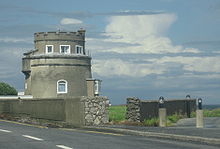 Portmarnock Martello tower, one of many on Ireland's east coast
Portmarnock Martello tower, one of many on Ireland's east coast
Great Britain and Ireland were united as a single political entity, the United Kingdom of Great Britain and Ireland, from 1801 to 1922, spanning the time during which the Martello towers were erected (the initial scheme started under the previous entities of the Kingdom of Great Britain and Kingdom of Ireland). Consequently the Martello towers of Great Britain and Ireland can be considered to have been part of a single defensive system, designed to protect the coastlines of the two main islands of the British Isles as a whole.[8][9]
This is most clearly visible on the south and east coasts of England and the east coast of Ireland, where chains of Martello towers were built. Elsewhere in the world, individual Martello towers were erected to provide point defence of strategic locations.
England
Between 1804 and 1812 the British authorities built a chain of towers based on the original Mortella tower to defend the south and east coast of England, Ireland, Jersey and Guernsey to guard against possible invasion from France, then under the rule of the Emperor Napoleon. A total of 103[6] Martello towers were built in England, set at regular intervals along the coast from Seaford, Sussex, to Aldeburgh, Suffolk. Most were constructed under the direction of General William Twiss (1745–1827) and a Captain Ford.[10][11]
Included in the scheme were three much larger circular forts or redoubts that were constructed at Harwich, Dymchurch and Eastbourne; they acted as supply depots for the smaller towers as well as being powerful fortifications in their own right.[12]
The effectiveness of Britain's Martello towers was never actually tested in combat against a Napoleonic invasion fleet. They were, however, effective in hindering smuggling.[13] After the threat had passed, the Martello towers in England met a variety of fates. The Coastguard took over many to aid in the fight against smuggling.
Fifteen towers were demolished to enable the re-use of their masonry. The sea washed thirty away and the military destroyed four in experiments to test the effectiveness of the new rifled artillery. During the Second World War, some Martello towers returned to military service as observation platforms and firing platforms for anti-aircraft artillery.
Forty-seven Martello towers have survived in England, a few of which have been restored and transformed into museums (e.g., the tower at St Osyth), visitor centres, and galleries (such as Jaywick Martello Tower). Some are privately owned or are private residences;[14] the remainder are derelict. A survey of the East Coast towers in 2007 found of the 17 remaining, most were in a reasonable condition.[15]
Scotland
Three Martello towers were built in Scotland, two at Hackness and Crockness near Longhope in the Orkney Islands. They were constructed between 1813 and 1815 to guard against the threat of French and American raiders attacking convoys assembling offshore.[16] Historic Scotland now operates the Hackness tower as a museum.[17]
A third Scottish tower was built on offshore rocks facing the Firth of Forth in 1807-09 to defend Leith Harbour. Known locally as the Tally Too'er, it now lies land-locked within the eastern breakwater.[18][19]
Ireland
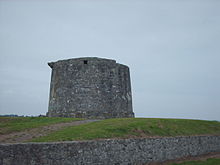 Martello tower at Balbriggan
Martello tower at Balbriggan
The British built about fifty Martello towers around the Irish coastline, especially along the east coast, from Millmount (Drogheda), to Bray, around Dublin Bay but also around Cork Harbour on the south coast. On the east coast, concentrated mainly around Dublin Bay, the towers were in line of sight of each other, providing the ability to communicate with one another, or warn of any incoming attacks.
Possibly the most famous is the Martello tower in Sandycove, near Dún Laoghaire, in which James Joyce lived for a few days. Joyce shared the tower with Oliver St. John Gogarty, then a medical student but later to become famous in Irish history as a surgeon, politician and writer. In Ulysses, the fictional character Stephen Dedalus lives in the tower with a medical student, Malachi "Buck" Mulligan, whom Joyce based on Gogarty. The James Joyce Tower, as the tower is now known, houses a museum dedicated to Joyce.
A number of other Martello towers are extant nearby at Bullock Harbour, Dalkey Island, Williamstown Seapoint and Sandymount and Martello towers feature in many literary works set in Dublin. During the 1980s, Bono owned the Martello tower in Bray, County Wicklow.
 Martello tower (No.7) at Killiney
Martello tower (No.7) at Killiney
Martello Tower No.7, on Tara Hill, Killiney Bay, is unique, as is its location as an enfilading tower. The Tower is privately owned and has been fully restored, to include a proofed, working King George 3rd Blomefield 18-pounder cannon mounted on a traversing carriage on the crown of the Tower. There is a three-gun battery below the tower, with a glacis. There is also a coach house, artillery store, tool shed, and gunner's cottage, with resident gunner and gunpowder store. The battery, while restored, remains to be armed and the coach house and artillery store still require some restoration. [20]
On the north side of the city, one can find Martello towers in Portmarnock, Howth, Sutton, Donabate, Malahide (Hicks tower) and on Ireland's Eye and Lambay Island.
There are seven Martello towers in the vicinity of Cork Harbour. During the 19th century Fenian uprising, the famous Captain Mackey briefly captured and held the Monning Martello tower near Fota Island in Cork Harbour; this tower is believed to have been the only Martello tower ever captured, other than the original. The other Cork Harbour towers are at Ringaskiddy, Haulbowline Island (now part of the Irish Naval Service HQ) and at Belvelly and Rossleague on the Great Island (near Cobh). There are also Martello towers at Little Island and Rostellan, though these are no longer intact.
The British built two Martello towers on the Hook Peninsula to protect the fort near Duncannon, Co. Wexford and the entrance to Waterford Harbour. There is a third tower on the headland at Baginbun Bay in Co. Wexford.
One of the most interesting Martello towers is in Meelick, Co. Offaly, guarding the river crossing on the River Shannon. As this tower supports three guns (unlike the normal Martello tower which is circular on plan and carries only one gun), it is cam shaped on plan. Currently a rampant growth of ivy covers the tower.
The tower at Seapoint, County Dublin, was formerly the headquarters of the Genealogical Society of Ireland (GSI).[21] The GSI vacated the tower when it found that the atmosphere was not conducive to the preservation of records.
The restored tower at Ilnacullin is a feature of an island garden in Glengarriff, County Cork. Several other towers are still extant, including one at Rathmullan in County Donegal.
Channel Islands
After the Battle of Jersey in 1781, the Governor of Jersey, Henry Seymour Conway embarked on a project to build coastal defences to protect the island from a repeat of the French invasion attempt. The first tower, Seymour Tower, which replaced an earlier tower on the same spot at La Rocque, was built of granite in 1782 and was the only square tower. Thirty round towers followed, positioned in strategic places all around the Island. The round towers differ from the UK Martello towers in two ways. The Jersey towers are mostly built with local granite rather than brick, and they have taller walls.[22]
During World War II, when the Germans occupied Jersey, they destroyed the tower erected on the Bel Royal area and replaced it with a bunker due to its strategic position. The Germans fortified other towers with concrete to use them as defences against allied troops. They used La Rocco Tower in St Ouen Bay as a target for artillery practice; the tower was restored after the war.[23]
To date, 24 of the original towers remain and some have been painted white and red to serve as navigational aids. Furthermore, one may hire, via the National Trust for Jersey, some of the towers, such as Victoria Tower, for short stays.[24] One can hire other towers, such as Archirondel shown on the picture, via Jersey Heritage.[25]
The latest Jersey pound note design (2010) has a picture of the St Clement's tower Le Hocq, this tower is also engraved on the reverse of the local 1p coin.
There are four "true" Martello towers in the Channel Islands. These are:
- Fort Kempt - Jersey
- Fort Grey - Guernsey
- Fort Hommet - Guernsey
- Fort Saumarez - Guernsey
Elsewhere
Antigua and Barbuda
The British originally constructed River Fort Martello Tower in the early 19th century to guard nearby River Landing, which was Barbuda's original quay. The tower is located on the south coast of the island, a mile or so from River Landing and some seven miles south of the island's main village of Codrington. The tower is 56 feet high, has a raised gun platform and extremely thick walls, but is missing the floors.
It is attached to a pre-existing fort, probably built by the Spanish. The tower mounted three cannon, and in all the fort mounted ten cannons, none of which remain. The tower is the highest building on Barbuda and serves as a navigating point from land or sea.
Fort Denison, Sydney Harbour.
Australia
The last Martello tower built in the British Empire is said to be that at Fort Denison, a small island in Sydney Harbour, New South Wales. It was built to protect Sydney against the threat of a naval attack by the Russians during the Crimean War of the 1850s. However, construction was completed only in 1857, well after the war had ended. Fort Denison is well preserved and is now a popular tourist attraction.
Bermuda
There is a Martello tower located at Ferry Reach in St George's Parish. The tower was restored in 2008 and an 18-pounder cannon brought from Fort St. Catherine was mounted on top. The site is open to the public from 10 a.m. to 2 p.m. Monday to Friday in the summer and in the winter by appointment only, by calling the Parks Department. It is part of the Bermuda Railway Trail.
The tower is the third fortification on the site.[26] Major Thomas Blanshard built it of Bermuda limestone from 1822-1823. Like its predecessors in the UK, it has an ovoid footprint with the thickness of its walls ranging from nine to 11 feet; also, a dry moat surrounds it. The tower's purpose was to defend the Ferry Beach Channel and so impede any attack on St. George's Island from the main island of Bermuda. The British planned, but never built, two more Martello towers to protect the old Royal Naval Dockyard.
British Virgin Islands
 Fort Recovery, in the British Virgin Islands.
Fort Recovery, in the British Virgin Islands.
When the British rebuilt Fort Recovery on the west end of Tortola they added a Martello tower.
Canada
Nine of the fourteen Martello towers built in Canada still survive.[27] (In addition, the existing fortifications at Fort Henry received two thin towers between 1845 and 1848. However, these are dry ditch defence towers, rather than true Martello towers.) A common characteristic of Canadian Martello towers was removable cone-shaped roofs to protect against snow. Today, many of the restored towers have permanent roof additions - for ease of upkeep, not historical accuracy.
 Restored interior of Carleton Martello Tower at Saint John, New Brunswick.
Restored interior of Carleton Martello Tower at Saint John, New Brunswick.
Halifax, Nova Scotia, had five towers, the oldest of which, the Prince of Wales Tower [28] located in Point Pleasant Park, is the oldest Martello-style tower in North America. It was built in 1796 and was used as a redoubt and a powder magazine. Restored, it is now a National Heritage site. The Duke of York Martello Tower[29] was built in 1798 at York Redoubt. Its lower level still stands, though it has been boarded up for conservation purposes. The Duke of Clarence Martello Tower[30] stood on the Dartmouth shore. Sherbrooke Martello Tower[31] stood opposite York Redoubt on McNabs Island. Another Martello tower stood on Georges Island.
Quebec City originally had four Martello towers. Tower No. 1 stands on the Plains of Abraham, overlooking the St Lawrence River. It has been restored as a museum and one may visit it during the summer months. Tower no. 2 stands close nearby and currently hosts an 1812 Murder Mystery Dinner. Tower No. 3 was demolished in the 20th century after being used as a residence. The fourth surviving Martello Tower in Quebec, No. 4, is located in a residential area on the north side of the Upper City overlooking Lower Town.
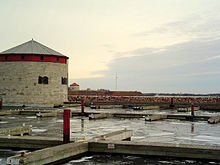 Line of defence: three Martello towers Fort Frederick, Shoal Tower, and Cathcart Tower in Kingston, Ontario
Line of defence: three Martello towers Fort Frederick, Shoal Tower, and Cathcart Tower in Kingston, Ontario
Four Martello towers were built at Kingston, Ontario to defend its harbour and naval shipyards in response to the Oregon Crisis. Their builders intended for the towers to serve as redoubts against marine attacks. Murney Tower and the tower at Point Frederick (at the Royal Military College of Canada) are now museums that are open during the summer.
Fort Frederick, has the most elaborate defences as it includes earthen ramparts and a limestone curtain wall. The Shoal Tower, the only tower completely surrounded by water, stands in Kingston's Confederation Basin. Since 2005, it is open to the public as part of Doors Open Ontario for one day only in June each year. Cathcart Tower, the fourth tower, stands unused on Cedar Island near Point Henry.
Carleton Martello Tower, overlooking the harbour of Saint John, New Brunswick, is now a museum and a National Historic Site.
The Canadian Press reported on April 16, 2006 that the Canadian military has named a Forward Operating Base (FOB) in Afghanistan FOB Martello. A Martello Tower is featured on the logo of the International Hockey Hall of Fame and Museum in Kingston, Ontario
Indonesia
The explosion of Krakatoa in 1883 caused a tidal wave that damaged the Martello tower (Martello Menara), that the Dutch East India Company built in 1850 on Bidadari Island (Pulau Bidadari), one of the Thousand Islands (Kepulauan Seribu), as part of a set of fortifications that protected the approaches to Batavia. The tower was operational until 1878, when it became a storage site, and was abandoned in 1908. Bidadari Island was also known as Pulau Sakit (Sick Island) as it housed a leper colony during the 17th century. More recently, the island came to be called "Angel Island", to honour the leprosarium that had been there.
Italy
At the beginning of the nineteenth century, during the British "Protectorate" of Sicily after the escape of the Bourbons from Naples, Sicily began to build towers to resist an invasion by Napoleon's armies led by Joachim Murat. The new higher rate of fire of ships' guns, led to the choice of the Martello tower as the model.
The Sicilian Martello towers were built around 1810. The estimate rests on the historical context and on the descriptions of the topographer W. H. Smith who carried out his research in 1814 and 1815. Of the seven towers built in Sicily, only two are still in existence. One is the Mazzone Tower (or the British Fort) at Faro Point, Messina. The second is the Magnisi tower at Priolo Gargallo, Syracuse. The Italian Navy used this tower as an observation post during the Second World War.
Jamaica
There is a Martello tower located at what was Fort Nugent. In 1709, the Spanish slave agent in Jamaica, James Castillo, built a fort in Harbour View, to guard his home against attack. An English Governor, George Nugent, later strengthened the fort to guard the eastern entrance of the city of Kingston Harbour. The tower was probably built between 1808 and 1811,[9] at a reported cost of £12,000.
Mauritius
The British built five Martello Towers between 1832 and 1835 at Grand River North West, Black River and Port Louis, of which three survive. The Friends of the Environment have restored one, near the La Preneuse public beach in Tamarin, and operate it as a museum for visitors. The original entrance to the tower is raised above ground but a new entrance has been constructed at ground level.
Sierra Leone
A Martello tower was built on Tower Hill at Freetown, Sierra Leone in 1805 to defend the port from attacks by the Temne people. It was significantly modified in 1870 when it was truncated to allow the installation of a water tank to supply Government House (Fort Thornton) with water. The tower has now been incorporated into Sierra Leone's Parliament Buildings.[32]
South Africa
The British built three Martello towers in South Africa, one at Simon's Town Naval base near Cape Town, one at Cape Town, and the third at Fort Beaufort. The tower at Simon’s Town and Cape Town were both built in 1795. The tower at Cape Town was demolished over 100 years ago, but the tower at Simon's Town now is sometimes claimed as the oldest Martello in the world. It is arguable as to whether one should properly call it a Martello Tower.[33]
That said, Vice Admiral George Elphinstone, who commanded the force that captured the colony and then served briefly as its governor, had served with the Mediterranean fleet off Corsica in 1794.[6] The British built the tower at Fort Beaufort in 1837, and it is probably the only example of an inland Martello tower.
Spain (Minorca)
During the last period of British occupation (1798–1802) of Minorca, Sir Charles Stuart, the then British governor, ordered Engineer Captain Robert D´Arcy to build some 12 Martello towers along the coast.[6] These, when added to the three Spanish towers already in place, gave Minorca 15 towers.[34]
The British built five towers to protect Mahón: Phillipet on Lazareto Island, Cala Taulera (St. Clair) and Los Freus (Erskine) on the peninsula of La Mola, Stuart's Tower, and a tower on the Punta de Sant Carlos, which the Spanish destroyed when they took regained possession of Minorca. To the northwest of Mahón the British built two more towers, Sa Torreta and Sa Mezquita.
One tower, the Princess Tower, or the Erskine Tower, was incorporated into the Fortress of Isabel II, built between 1850 and 1875. The tower was converted to a powder magazine, which led to its destruction in 1958, when lightning struck the tower. The explosion destroyed the tower, blowing out large sections of its walls.
The British erected Stuart's Tower in 1798 on Turks Hill or Hangman's Hill to the south of the port of Mahón at San Estaban or Saint Stephen's bay on the southern side of the Fortress of San Felipe. In 1756 and again in 1781, batteries on the hill had supported successful attacks on the Fortress. The tower was built both to secure the hill and protect the entrance to the bay. The tower's name was later changed to Torre d´en Penjat, or Hangman's Tower.
To protect the harbor of Fornells, the British built a tower on the rocky headland overlooking the harbor's mouth, and a small tower on the island of Sargantana. They complemented these two towers with two more small towers nearby, one at Sa Nitsa and one at Addaya.
Lastly, the British built one tower at Santandria to protect the old capital of Ciudadela.
In addition to the 12 towers that they built, the British made use of three towers that the Spanish had built earlier.[34] In 1781, Captain Francisco Fernandez de Angulo had built towers south of Port Mahon at Punta Prima and Alcufar, based on the design of those that the Spanish had built in Gando, Gran Canaria, in 1740. At Ciudadela the British used the St. Nicholas's Tower, built in 1690. The Treaty of Amiens returned Minorca to Spain in 1802. Around 1804, the Spanish built a tower at Punta Na Radona to protect the beach at Son Bou, Minorca. In 1808, Captain Lord Cochrane, commanding the 38-gun fifth-rate frigate Frederick Marryat, later a naval captain and author, was serving as a midshipman aboard Imperieuse at the time.) (This fort has 17 walls)
Saint Helena
There is a Martello tower at Saint Helena that was incorporated into High Knoll Fort. The tower was very similar in design to the tower at Simon's Town, with a diameter of about 45ft (13.8m) and a height of approximately 20ft (6.15m).[9]
Sri Lanka
Sri Lanka has one Martello tower, located at Hambantota on the south coast, which was restored in 1999.[35] This tower may have been involved in repelling a French attack though there is nothing more than circumstantial support for the notion. British engineers commenced work on three towers to protect Trincomalee but never completed them.[9]
United States
The United States government built several Martello towers at locations along the eastern seaboard. Two are at Key West, Florida; others were built at the harbours of Portsmouth, New Hampshire, Charleston, South Carolina and New York City. Two more Martello towers stood at Tybee Island, Georgia and Bayou Dupre, Louisiana.[36]
Although the Americans copied the design from the towers the British erected in Canada, the American Martello towers differed in some significant respects from the British. The Martello tower built at Tybee Island, Georgia was constructed around 1815 utilizing wood and tabby, a common local building material at the time, instead of the brick or stone that the British towers used. Also unlike the British towers, the Tybee tower featured gun loops on the garrison floor that enabled muskets to be fired through the walls.[7]
It was never tested in battle and by the time of the American Civil War was in a state of disrepair. Its unfamiliar design confused local writers, who often said that the Spanish had built the tower when Georgia was Spain's colony.[7] The Key West martellos were square instead of round and had thin walls with long gun loops. In addition, the Key West Martellos were encircled by a curtain wall of heavy guns, making them, effectively, keeps instead of standalone towers.
A Martello tower figures in the arms of the 41st Infantry Regiment of the United States Army.[37]
List of Martello towers outside Great Britain
Country Location Tower name Built Current status Australia Sydney Fort Denison 1856 Museum, harbour light station. Barbuda Near Codrington River Fort Martello Tower Bermuda Ferry Reach 1823–1828 Can be visited British Virgin Islands Tortola Fort Recovery Private (hotel) Canada Halifax, Nova Scotia Prince of Wales's Tower 1796 Open to public Halifax, Nova Scotia Duke of York's Tower c.1798 Lower levels still exist. Site partially boarded off, can be visited Halifax, Nova Scotia Duke of Clarence's Tower c.1798 Demolished prior to 1900 Kingston, Ontario Fort Frederick 1846/7 Museum Kingston, Ontario Murney Tower 1846 Museum Kingston, Ontario Shoal Tower 1846 Closed to Public Kingston, Ontario Cathcart Tower 1846 Closed to Public Quebec City, Quebec Tower #1 1808–1812 Museum Quebec City, Quebec Tower #2 1808–1812 Open for group activities through National Battlefields Commission Quebec City, Quebec Tower #3 1808–1812 Destroyed Quebec City, Quebec Tower #4 1808–1812 Closed to Public Saint John, New Brunswick Carleton Martello Tower 1815 Museum Ireland Achill Island Aughinish Aughinish Tower Private Residence Balbriggan Banagher Meelick Tower Private residence Bere Island Cloughland Bere Island Ardagh Bray No.1 Demolished when Esplanade constructed Bray No.2 Private residence Bray No.3 Corke Abbey Demolished Shankill, Dublin No.4 Mahera Point Fell into sea Killiney No.6 Enoch's Tower Private Residence Killiney No.7 Tara Hill Fully restored Dalkey Island No.9 Abandoned Bulloch Harbour Private residence Finavarra Finavarra Tower 1816 Open to public Ringaskiddy, Cork Harbour Haulbowline Island, Cork Harbour Museum, owned by Irish Navy Fota Island, Cork Harbour Monning Tower Rossleague, Cobh Belvelly, Cobh Private Residence Howth Museum & radio station Ilnacullin Tower and gardens open to public (access by boat from Glengarriff) Ireland's Eye Kingstown Harbour, West Pier Demolished, c. 1830s, during construction of Harcourt Street railway line Lambay Island Lough Swilly Macamish Tower Lough Foyle Greencastle Tower Extended to a Fort completed in 1812. Restaurant Lough Foyle Magilligan Tower Restored Loughshinny Portmarnock Private residence Rathmullan Rosaveel Rush, Dublin Ruins Sandycove James Joyce's Martello tower Museum Sandymount Seapoint Headquarters of the Genealogical Society of Ireland Shenick Island Sutton Private residence Williamstown Jamaica Kingston Fort Nugent 1808-11? Liberia Monrovia Fort Stockton 1822 since 1822, august under construction, later named as coast battery Fort Hill[38] Mauritius Tamarin 1832-35 L'Harmonie 1832-35 La Preneuse 1832-35 Museum Cunningham's Tower 1832-35 Disappeared between 1880 and 1902. Fort Victoria 1832-35 Last mentioned 1880 Sierra Leone Freetown Tower Hill Martello Tower 1805 Part of Parliament Buildings South Africa Fort Beaufort 1839-46 Simon's Town 1795/6 At the Naval Base. Houses a small museum. Cape Town Craig's Tower 1795/6 Demolished late 19th Century Sri Lanka Hambantota 1801-03 Trinidad & Tobago Port of Spain Fort Picton 1801 Abandoned by 1810. United States Lake Borgne (LA) Tower Dupre 1830? Hexagonal; originally built on shore, 150 ft (46 m) from water, near Bayou Dupre's entrance to Lake Borgne; private fishing camp; threatened by subsidence and tidal erosion[39] Charleston (SC) Key West (FL) East tower is a museum; West tower converted to a botanical garden; both open to the public New York Harbor Destroyed Portsmouth, NH Walbach Tower 1814 Incorporated into Fort Constitution; Ruined[40] Tybee Island (GA) 1815 Destroyed See also
Lists:
References and sources
- Notes
- ^ "Sir John Moore, 1761-1809". Johnwheater.net. 2006-03-28. http://www.johnwheater.net/Moore.php#Pix. Retrieved 2010-12-21.
- ^ Vigano (2001), pp. 41–57.
- ^ Abram (2003), p. 103.
- ^ Abram (2003), p. 103.
- ^ The London Gazette, March 15, 1794
- ^ a b c d e Sutcliffe (1973).
- ^ a b c d Ciucevich (2005), pp. 19-21.
- ^ Rooke (1857), p.68.
- ^ a b c d Clements (1998).
- ^ Mead (1948), pp. 205-17, 294-303.
- ^ Ward (1949), pp. 18-37.
- ^ "Dymchurch Redoubt". Martello-towers.co.uk. 2009-06-16. http://www.martello-towers.co.uk/south-coast/towers/dymchurch-redoubt.htm. Retrieved 2010-12-21.
- ^ Daly (2007), p.34.
- ^ Glancey, Jonathan (2010-12-20). "Napoleon-proof your home: convert a Martello tower". The Guardian. http://www.guardian.co.uk/artanddesign/2010/dec/20/martello-tower-conversion. Retrieved 2010-12-21.
- ^ Millward (2007), 173-184.
- ^ "Hackness Martello Tower". Undiscovered Scotland. http://www.undiscoveredscotland.co.uk/hoy/hackness/index.html. Retrieved 2007-07-13.
- ^ "Hackness Martello Tower and Battery". Visit Scotland. http://www.historic-scotland.gov.uk/properties_sites_detail.htm?propertyID=PL_147. Retrieved 2007-07-13.
- ^ "Leith Martello Tower". Gazetteer for Scotland. http://www.scottish-places.info/features/featurefirst10725.html. Retrieved 2007-07-13.
- ^ "The Martello Tower". History of Leith. 2004-05-26. http://www.leithhistory.co.uk/2004/05/26/the-martello-tower/. Retrieved 2007-07-13.
- ^ "Tower No. 7". Photopol.com. 2008-07-12. http://www.photopol.com/martello/no7.html. Retrieved 2010-12-21.
- ^ "Welcome to the Genealogical Society of Ireland". Familyhistory.ie. http://www.familyhistory.ie. Retrieved 2008-10-24.
- ^ [1] National Trust for Jersey - Military
- ^ [2] La Rocco Tower
- ^ [3] National Trust for Jersey - Victoria Tower
- ^ [4] Hersey Heritage - Archirondel
- ^ Harris (1988).
- ^ Saunders (1976).
- ^ [5][dead link]
- ^ "Public Archives of Nova Scotia C@P Site - The Royal Engineers in Halifax - Exhibit". Gov.ns.ca. http://www.gov.ns.ca/nsarm/cap/royalengineers/exhibit.asp?ID=156. Retrieved 2008-10-24.[dead link]
- ^ "Fort Clarence". The Royal Engineers in Halifax. Public Archives of Nova Scotia. http://www.gov.ns.ca/nsarm/cap/royalengineers/Results.asp?Search=Buildings%20-%20Military%20-%20Martello%20Tower:%20%20Duke%20of%20Clarence%27s%20Tower,%20Fort%20Clarence.
- ^ "Sherbrooke". Chebucto.ns.ca. http://www.chebucto.ns.ca/environment/FOMIS/Gallery/Buildings/pages/Sherbrooke.html. Retrieved 2008-10-24.
- ^ "National Tourist Board - Heritage Sites". Welcometosierraleone.org. Archived from the original on 2008-06-04. http://web.archive.org/web/20080604073434/http://www.welcometosierraleone.org/heritage-sites.asp#Martello. Retrieved 2008-10-24.
- ^ Brock & Brock (1976), p.162.
- ^ a b Grundy (1991).
- ^ McCall (1999).
- ^ Angus Konstam, American Civil War Fortification: Coastal Stone Forts. Osprey Publishing, 2003
- ^ "41st Infantry Regiment". Tioh.hqda.pentagon.mil. Archived from the original on 2008-05-27. http://web.archive.org/web/20080527145914/http://www.tioh.hqda.pentagon.mil/Inf/41+Infantry+Regiment.htm. Retrieved 2008-10-24.
- ^ Frederick Starr: Liberia. Description, History, Problems. Chicago 20 November 2011, p. 61, 251. als Digitalisat
- ^ Codman Parkerson, New Orleans, America's Most Fortified City. The Quest, 1990
- ^ "SeacoastNH.com - The Forgotten Walbach Tower". Seacoastnh.com. http://seacoastnh.com/Places_&_Events/Historic_Portsmouth/The_Forgotten_Walbach_Tower/. Retrieved 2008-10-24.
- Sources
- Abram, David (2003) The Rough Guide to Corsica Rough Guides.
- Brock, B.B. & Brock, B.G. (1976) Historical Simon's Town. (Cape Town). ISBN 0869610554
- Ciucevich, Robert A. (2005) Tybee Island: The Long Branch of the South (Arcadia Publishing).
- Clements, William H. (1998) Towers of Strength: Story of Martello Towers. (London: Pen & Sword). ISBN 978-0-85052-679-0.
- Daly, Gavin (2007). "English Smugglers, the Channel, and the Napoleonic Wars, 1800-1814". Journal of British Studies 46 (1): 30–46. doi:10.1086/508397.
- Grundy, Mark (1991). "The Martello Towers of Minorca". Fort (Fortress Study Group) 19: 22–58.
- Harris, Edward (1988). "The Martello Tower at Ferry Point, St George's Island, Bermuda". Mariner's Mirror 74 (1): 131–139.
- McCall, M. (1999). "The Martello Tower in Hambantota, Sri Lanka". Fort (Fortress Study Group) 27: 143–158.
- Mead, H.P. (1948). "The Martello Towers of England". Mariner's Mirror 34: 205–17 & 294–303.
- Millward, J. (2007). "The East Coast Martello Towers". Fort (Fortress Study Group) 35: 173–184.
- Rooke, Octavius (1857) The Channel islands: pictorial, legendary and descriptive.
- Saunders, Ivan J. (1976) "A History of the Martello Towers in the Defence of British North America, 1796-1871", Occasional Papers in Archaeology and History #15, National Historic Parks and Sites Branch, Thorn Press Limited.
- Sutcliffe, Sheila (1973) Martello Towers. (Cranbury, NJ: Associated Universities Press).
- Vigano, M. (2001) Fort (Fortress Study Group) 29.
- Ward, S.G.P. (1949). "Defence Works of Britain, 1803-1805". Journal of the Society for Army Historical Research 27: 18–37.
External links
- Martello Towers, both Ireland & worldwide
- Martello Tower at Red Rock Sutton, Dublin
- Restoration of No.7 Tower, Killiney Bay
- Interactive Google Map of Killiney Bay defences
- Carleton Martello Tower National Historic Site of Canada
- English Heritage Martello towers definition and description
- The Dymchurch tower: English Heritage
- James Joyce Tower, Dun Laoghaire
- Martello Towers homepage - a guide to England's south coast Martello towers
- Note on Sir John Moore - pictures of the original tower at Mortella
- Mortella Point (Punta Mortella) in Corsica - the ancestor of Martello towers all over the world
- Seapoint Martello Tower, Co. Dublin Genealogical Society of Ireland (Restoration of an Irish Martello tower)
- Eastbourne Redoubt Fortress Military Museum
- Eastbourne Redoubt
- The National Battlefields Commission - Quebec city's Martello Towers
- National Trust for Jersey Self catering Martello Tower
Categories:- Fortification
- Towers
- Military history of Kent
- Napoleonic forts in England
- Napoleon's planned invasion of the United Kingdom
- Military forts in Canada
- Coastal artillery
Wikimedia Foundation. 2010.

